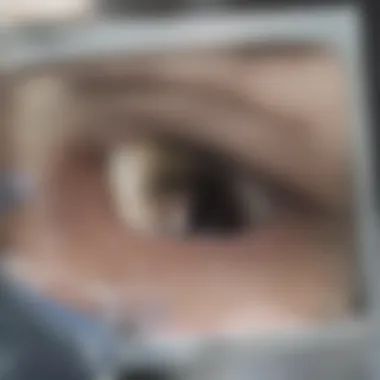Restor IOL Lens: A Comprehensive Exploration


Article Overview
Purpose of the Article
This article aims to provide a detailed examination of the Restor Intraocular Lens (IOL). It highlights the IOL's unique design, the surgical methods employed during its implantation, and the clinical outcomes associated with its use. By synthesizing current research and expert opinions, the article intends to empower healthcare professionals and informed patients with comprehensive knowledge on this specific lens. This information is essential for making informed decisions regarding cataract surgery and the various strategies for vision restoration.
Relevance to Multiple Disciplines
The topic pertains to multiple disciplines, including ophthalmology, optometry, and surgical education. The Restor IOL represents a significant advancement in the treatment of cataracts and presbyopia, thereby influencing fields that range from patient management and surgical techniques to future research initiatives in vision correction. An understanding of this IOL is crucial not just for ophthalmologists, but also for optometrists, gerontologists, and rehabilitation specialists.
Research Background
Historical Context
The development of intraocular lenses represents a pivotal shift in cataract surgery. Initially, cataracts were primarily treated through techniques that involved the removal of the cloudy lens without replacing it. Over time, the introduction of IOLs transformed this procedure, offering patients improved vision post-surgery. The Restor IOL, in particular, emerged as a response to the increasing demand for multifocal capabilities, addressing both near and far vision requirements.
Key Concepts and Definitions
Understanding the Restor IOL necessitates familiarity with several key concepts:
- Cataract: A condition characterized by clouding of the lens of the eye, leading to decreased vision.
- Intraocular Lens (IOL): A synthetic lens implanted inside the eye to replace the eye's natural lens after cataract removal.
- Multifocal Lens: A type of lens designed to provide clear vision at multiple distances, catering to patients with presbyopia.
The Restor IOL enhances the traditional multifocal design by incorporating advanced technology such as apodized diffractive optics, improving the quality of vision and reducing visual disturbances.
"The Restor IOL is a culmination of years of innovation, merging surgical precision with advanced optical science to achieve multifocal vision correction."
"The Restor IOL is a culmination of years of innovation, merging surgical precision with advanced optical science to achieve multifocal vision correction."
Preamble to Restor IOL Lens
The Restor Intraocular Lens (IOL) represents a significant advancement in the field of ophthalmology, specifically pertaining to vision restoration. Understanding this topic is essential as it encompasses multiple dimensions of cataract surgery and patient care. The importance of Restor IOL lies not only in its design and functionality but also in its impact on the quality of life for patients who undergo lens implantation. By examining the details of Restor IOLs, professionals in the field can make informed decisions that affect both procedural outcomes and patient satisfaction.
Understanding Intraocular Lenses
Intraocular lenses are artificial lenses implanted in the eye, typically during cataract surgery. They replace the eye's natural lens that has become cloudy. Various types of intraocular lenses exist, including monofocal, multifocal, and accommodating lenses. Restor IOLs are a type of multifocal lens designed to provide patients with a greater range of vision. Importantly, they aim to minimize the need for glasses or contact lenses post-surgery. The design of these lenses allows for focusing at different distances, facilitating easier transitions from near to distant vision, which is essential for everyday activities like reading and driving.
The Evolution of Restor IOL Technology
The technology behind Restor IOLs has progressed significantly over recent years. Initially, intraocular lenses were primarily monofocal, meaning they could only correct vision at one distance. However, advancements in optical science have led to the emergence of multifocal lenses like Restor. Their design integrates multiple zones, each optimized for different visual ranges. This evolution in lens technology addresses common issues faced by patients with cataracts and presbyopia. Moreover, ongoing research continuously improves the optical quality and functionality of these lenses, making them more appealing to both surgeons and patients.
"Restor IOLs symbolize a leap towards better patient outcomes by addressing complex refractive needs effectively."
"Restor IOLs symbolize a leap towards better patient outcomes by addressing complex refractive needs effectively."
In summary, the exploration of Restor IOLs unveils essential insights into how these lenses operate, the considerations for their implementation, and their extensive benefits. Understanding their role in cataract surgery strengthens the foundation upon which skilled and informed ophthalmic practitioners can enhance patient experiences and outcomes.
Design Principles of Restor IOL
The design principles of Restor IOL are critical to understanding their functionality and the advantages they offer in cataract surgery. By emphasizing optical characteristics, material composition, and multifocality, these lenses provide a comprehensive solution to patients experiencing vision loss. Each design aspect contributes not just to the physical structure of the lens, but also affects patient outcomes, comfort, and overall visual experience.
Optical Characteristics
The optical characteristics of Restor IOLs are specially engineered to enhance visual clarity. These lenses employ advanced technology to achieve a balance between distance and near vision. Specifically, they use diffractive technology, which allows the lens to focus light at multiple focal points. This is essential for patients who wish to reduce their dependence on glasses after surgery.
Some key features of the optical design include:
- Aspheric design: This design helps to minimize spherical aberrations, thereby improving image quality.
- Controlled light distribution: By distributing light evenly among various focal points, Restor IOLs provide clearer vision across different distances.
- Interference filters: These reduce glare and enhance contrast sensitivity, which is particularly useful in low-light conditions.
These optical principles are vital for ensuring that patients can adapt to their new lenses while maintaining high-quality vision.
Material Composition
Material composition is another crucial factor in the efficacy of Restor IOLs. These lenses are typically made from hydrophobic acrylic or silicone, materials chosen for their biocompatibility and optical clarity. The choice of materials significantly influences not just the lens's performance but also its long-term behavior within the eye.


Important aspects of material composition include:
- Flexibility: The materials used in Restor IOLs allow for a foldable design, which is important for implantation through smaller incisions.
- Stability: High-quality materials ensure that the lens maintains its shape and performance over time, reducing the risk of complications.
- UV Protection: Many Restor IOL designs also incorporate UV filters that help in blocking harmful rays, adding a layer of protection for the retina.
The use of these advanced materials leads to better surgical outcomes and enhances patient satisfaction, as they contribute to improved visual experiences and quicker recovery times.
Multifocality Explained
Multifocality is a defining feature of Restor IOLs and plays a significant role in their design principles. Unlike traditional monofocal lenses, multifocal lenses can offer clear vision at various distances. This is achieved through a design that incorporates multiple zones optimized for near, intermediate, and distance vision.
There are several key points to understand:
- Zone distribution: The lens is designed with different zones that allow the eye to focus on objects close-up, at arm's length, and at a distance.
- Adaptive vision: Patients can often engage in various activities without needing glasses, from reading a book to driving at night.
- Potential trade-offs: Some patients may experience halos or glare, particularly in low-light conditions, which is a consideration for those considering Restor IOL implantation.
Overall, the multifocal design exemplifies the focus on patient-centered outcomes, allowing for greater independence from corrective eyewear.
"Understanding the design principles of Restor IOL is essential for recognizing their role in modern ophthalmology and the advancements they bring to cataract surgery."
"Understanding the design principles of Restor IOL is essential for recognizing their role in modern ophthalmology and the advancements they bring to cataract surgery."
Surgical Procedures Involving Restor IOL
Surgical procedures involving the Restor Intraocular Lens are crucial for successful cataract treatment and vision restoration. The complexity and precision of these surgeries play a significant role in determining patient outcomes. Successful implantation of Restor IOLs not only alleviates cataracts but also enhances visual quality, paving the way for better daily function.
Preoperative Assessment
A thorough preoperative assessment is essential in ensuring that patients are suitable candidates for Restor IOL surgery. Several factors must be evaluated during this phase:
- Patient History: Understanding the medical and ocular history of the patient helps in identifying any potential risks or complications.
- Visual Acuity Testing: Establishing baseline visual acuity provides a benchmark to measure postoperative success.
- Corneal Examination: This includes assessing corneal shape, thickness, and any surface irregularities that may affect IOL positioning.
- Biometric Measurements: Accurate measurements of the eye—such as axial length and anterior chamber depth—are vital for calculating the optimal lens power.
These assessments guide ophthalmologists in making informed decisions regarding surgical techniques and the specific type of IOL to implant.
Surgical Technique Overview
The surgical technique for Restor IOL implantation typically involves the following steps:
- Anesthesia: Local or topical anesthesia is usually applied to ensure patient comfort.
- Phacoemulsification: The surgeon uses ultrasound to break up the cloudy lens, allowing it to be gently removed through an incision.
- IOL Insertion: The Restor lens is carefully folded and inserted through the same incision.
- Positioning: Once in place, the lens unfolds and centers correctly within the capsular bag.
- Closure: The incision is often self-sealing, reducing the need for sutures.
Educating patients about what to expect during surgery helps reduce anxiety and improves cooperation during the procedure.
Postoperative Management
Postoperative management is crucial for optimizing recovery and ensuring the success of the Restor IOL. Following surgery, patients typically undergo:
- Follow-up Visits: Regular post-surgery check-ups to monitor healing and assess visual performance.
- Medication: Patients might be prescribed antibiotic and anti-inflammatory eye drops to prevent infection and manage discomfort.
- Activity Guidelines: Patients receive instructions on activities to avoid, such as heavy lifting or swimming, during the early recovery phase.
The careful management of these aspects helps in achieving better visual acuity and overall satisfaction with Restor IOL implantation.
Successful integration of Restor IOLs into surgical practice relies heavily on these carefully managed procedures, from assessment to recovery.
Successful integration of Restor IOLs into surgical practice relies heavily on these carefully managed procedures, from assessment to recovery.
Clinical Outcomes of Restor IOL Implantation
The clinical outcomes of Restor IOL implantation are crucial for understanding the overall success and patient satisfaction associated with the procedure. Evaluating these outcomes gives healthcare professionals insights into the effectiveness of Restor IOLs. This section examines three key elements: visual acuity results, patient satisfaction metrics, and long-term efficacy studies.
Visual Acuity Results
Visual acuity is often the primary goal of cataract surgery, and Restor IOLs have shown promising results in this area. Studies indicate that most patients experience significant improvements in their visual acuity following implantation.
- Immediate Improvement: Many patients report enhanced vision almost immediately post-surgery. This benefit comes from the lens's ability to focus light more effectively.
- Comparative Analysis: Compared to traditional monofocal lenses, Restor IOLs provide better functional range, allowing patients to see clearly at various distances. Research supports that over 80% of patients achieve 20/25 vision or better.
- Factors Influencing Outcomes: Factors such as pre-existing ocular conditions and age can impact the outcomes. Therefore, detailed preoperative assessments are essential.
In summary, high visual acuity rates underscore the effectiveness of Restor IOLs, making them a prominent choice for patients undergoing cataract surgery.


Patient Satisfaction Metrics
Evaluating patient satisfaction is another important component when assessing clinical outcomes of Restor IOL implantation. A patient's experience can inform future practices and improve overall care in ophthalmology.
- Surveys and Questionnaires: Various studies use validated surveys to assess satisfaction post-implantation. Notably, the majority of patients report a high level of satisfaction, often exceeding 90%.
- Diverse Needs Addressed: Restor IOLs are designed to reduce the need for spectacles. Many patients appreciate being able to engage in activities such as reading or driving without corrective lenses.
- Quality of Life Improvements: Enhanced visual capabilities lead to an improved quality of life for many patients. This improvement is particularly relevant for older adults, as they may have relied on glasses for years.
These satisfaction metrics are indicative of the Restor IOL’s efficacy in meeting the needs of diverse patient populations.
Long-Term Efficacy Studies
Long-term efficacy is a significant concern for both patients and specialists. The durability of visual improvements and patient satisfaction over time can influence decision-making when considering cataract surgery.
- Follow-Up Studies: Longitudinal studies reveal that the benefits of Restor IOLs can persist for many years following implantation, with many patients maintaining their visual acuity over time.
- Risks and Complications: While complications are rare, they can occur. Reviewing long-term data helps in understanding potential risks, including issues like glare or halos around lights.
- Future Directions: Ongoing research aims to optimize lens designs and address any long-term complications noted. This continuous evaluation is necessary to enhance patient outcomes and satisfaction further.
Benefits of Restor IOLs
The Restor intraocular lens (IOL) offers numerous benefits that enhance visual outcomes for patients undergoing cataract surgery. These IOLs have transformed how ophthalmologists approach vision correction. Several specific advantages emerge from the use of Restor IOLs, ultimately improving both individual experiences and broader public health outcomes. Key elements include enhanced depth of field, reduced dependence on glasses, and an overall improved quality of life for individuals.
Enhanced Depth of Field
One of the primary advantages of Restor IOLs is their ability to provide an enhanced depth of field. This means patients can achieve clear vision across a range of distances without the need for multiple pairs of glasses.
- Multifocal Design: The design of a Restor IOL allows multiple focal points, which helps in seeing near, intermediate, and far distances clearly.
- Improved Visual Range: Users often report that they can engage in daily tasks such as reading, driving, and using electronic devices without frequent adjustments to their vision.
Research indicates that patients experience fewer visual disturbances in various lighting conditions. This aspect is especially valuable in low-light environments. Restor IOLs allow for smoother transitions between different visual experiences, promoting a sense of comfort and ease in daily activities.
Reduction in Dependence on Glasses
Many patients seek cataract surgery to eliminate or at least reduce their reliance on glasses. Restor IOLs significantly contribute to achieving this goal.
- Fewer Glasses: With improved multifocal capabilities, many patients find they need glasses less frequently for reading or other near-vision tasks.
- Convenience: This reduction enhances convenience and promotes independence. Patients can engage in activities without the worry of misplaced or forgotten glasses.
While individual results may vary, numerous clinical studies have shown that a significant percentage of patients report being less dependent on glasses following the implantation of a Restor IOL. This shift can lead to heightened confidence in social and professional settings, further affirming the lens's practical benefits.
Improved Quality of Life
Ultimately, the use of Restor IOLs leads to an improved quality of life for patients recovering from cataract surgery. The cumulative effects of better vision and reduced reliance on corrective eyewear contribute to a sense of well-being among users.
- Increased Freedom: Patients express feelings of freedom and flexibility, allowing for more spontaneous activities. This includes participating in hobbies that might have been challenging due to visual limitations.
- Positive Emotional Impact: Many individuals report enhanced emotional well-being as their vision improves, leading to increased participation in social interactions.
"Patients with Restor IOLs often experience a remarkable transformation in their everyday lives, contributing to both mental and emotional health improvements."
"Patients with Restor IOLs often experience a remarkable transformation in their everyday lives, contributing to both mental and emotional health improvements."
Challenges and Considerations
Understanding the challenges and considerations involved in Restor IOL technology is vital. This segment assesses potential complications, patient selectivity, and economic factors that influence the adoption and effectiveness of these lenses. A comprehensive perspective on these aspects allows healthcare providers to better inform their patients, leading to more personalized and effective treatment strategies.
Potential Complications
Restor IOL implantation, while generally safe, can present certain complications that need consideration. Some patients may experience visual disturbances such as glare or halo effects. These symptoms arise from the lens's multifocal design, which can affect light entering the eye. Other possible complications include:
- Posterior capsule opacification: A common post-operative issue that may require further surgical intervention.
- Infection: Though rare, endophthalmitis can occur post-surgery, warranting vigilant postoperative care.
- Dislocation: The lens can shift position within the eye, necessitating repositioning or replacement.
Proper patient education regarding these risks is essential. Surgeons must conduct thorough discussions, ensuring that patients have a realistic understanding of what to expect after surgery.
Patient Selectivity
Patient selection plays a critical role in determining the success of Restor IOL surgery. Not all individuals are ideal candidates for multifocal lenses. Factors influencing selection include the patient's overall health, eye condition, and lifestyle needs. For example, patients with significant astigmatism may benefit less from Restor IOLs.
The selection process involves:
- Comprehensive eye exams: Assessing visual acuity and overall health.
- Discussion of lifestyle needs: Understanding daily activities and vision requirements helps tailor recommendations.
- Informed consent: Patients should be equipped with information about the benefits and risks associated with Restor IOLs.


Engaging in thoughtful patient selectivity ensures better outcomes and satisfaction, reducing the likelihood of complications.
Economic Factors
Economic considerations are essential when evaluating the use of Restor IOLs. The cost of these lenses, compared to traditional monofocal lenses, can be a significant factor. Restor IOLs typically involve higher initial expenses due to advanced technology and materials used in their design.
Aspects to examine include:
- Insurance coverage: Many insurance plans have varying coverage for premium lenses, which can affect patient decisions.
- Long-term cost savings: Although upfront costs may be higher, the reduced dependence on glasses or contact lenses can lead to savings over time.
- Accessibility of technology: Availability and affordability of Restor IOLs can differ by region and influence the number of patients opting for them.
Understanding the economic landscape surrounding Restor IOLs is crucial for both patients and providers.
Understanding the economic landscape surrounding Restor IOLs is crucial for both patients and providers.
Overall, the challenges and considerations associated with Restor IOLs must not be overlooked. A thorough analysis allows for improved decision-making, ensuring that patient needs, safety, and economic viability are prioritized.
Future Directions in Restor IOL Development
The field of intraocular lenses (IOLs) is constantly evolving, with an increasing emphasis on enhancing the patient experience and improving clinical outcomes. Understanding the future directions in Restor IOL development is crucial for health care professionals, researchers, and patients alike. These advancements are not merely technical; they involve an intricate interplay of patient needs, technological capabilities, and systemic requirements in ophthalmology. By anticipating these developments, stakeholders can better prepare for and incorporate new innovations into practice.
Innovative Designs on the Horizon
Future innovations aim to refine the existing designs of Restor IOLs. One of the promising advancements is the introduction of newer multifocal lens configurations that enhance depth of focus and reduce glare and halos, common issues faced in current models. These innovations may incorporate aspherical optics, which improve image quality across various distances.
Some designs focus on providing a more pronounced differentiation in focal lengths, broadening the range of visual acuity beyond the immediate and distant focus.
"The evolution of IOL design is moving towards personalized solutions that cater to the unique visual needs of each patient."
"The evolution of IOL design is moving towards personalized solutions that cater to the unique visual needs of each patient."
Moreover, the development of diffractive and refractive multifocal lenses continues, focusing on reducing aberrations and enhancing overall visual experience in diverse lighting conditions. This necessitates advanced customization techniques, which are likely to emerge in the coming years.
Research Trends in Multifocal Lenses
Ongoing research is crucial for shaping the landscape of multifocal lenses. Recent studies delve deeper into understanding how different lens structures affect patient satisfaction and visual performance. Research is currently leaning towards exploring new materials and surface treatments that minimize light scattering and improve the contrast of visual outcomes.
Clinical trials are also assessing the longevity and durability of new lens materials against aging factors. Understanding the long-term behavior of these lenses will inform future innovations and adaptability of the lenses during cataract procedures.
Furthermore, researchers are investigating how individual patient factors, such as age, lifestyle, and specific ocular characteristics, influence lens performance. This patient-centric approach ensures lenses are made to enhance the quality of life effectively.
Personalized Vision Correction Strategies
Future initiatives in Restor IOL development advocate for more personalized approaches to vision correction. This customization may extend to identifying patients' specific visual needs before surgery. Integrating technology such as wavefront analysis can provide detailed insights into an individual's visual system, leading to tailored lens options.
Healthcare providers are encouraged to engage patients in the decision-making process, presenting the choice of lens not just as a commodity but as a means to achieving their optimal visual experience.
Incorporating data analytics can also provide predictive models for expected outcomes based on patient profiles, which allows for more accurate guidance when selecting the appropriate lens.
In summary, the future of Restor IOL development looks promising, characterized by innovative designs, focused research, and personalized strategies that take patient experiences into account. As this field progresses, it holds the potential for broader applications in vision restoration, ultimately enhancing the quality of life for patients undergoing cataract surgery.
The End
In the context of this article, the conclusion serves as a critical element to distill the valuable insights gathered throughout the exploration of Restor IOLs. It encapsulates the significance of understanding the intricate details of this advanced lens technology. The conclusions drawn not only help in clarifying the benefits and limitations but also guide healthcare professionals and patients in making informed choices regarding cataract surgery.
Summary of Key Points
The key points highlighted in the article include:
- Understanding Intraocular Lenses: The foundation of Restor IOLs, including their design and technology evolution,
- Surgical Procedures: A comprehensive review of preoperative assessments, surgical techniques, and postoperative management that affect outcomes,
- Clinical Outcomes: Specific metrics related to visual acuity, patient satisfaction, and long-term efficacy of Restor IOLs,
- Benefits and Challenges: Both advantages like enhanced depth of field and challenges such as potential complications and economic factors are discussed,
- Future Directions: The advancement trajectory and research trends in multifunctional lenses are explored.
By integrating these components, a holistic understanding of Restor IOLs emerges. The evidence presented encourages a deeper appreciation for the multiple factors influencing both medical professionals and patient choices.
Final Thoughts on Restor IOLs
As we conclude this comprehensive exploration, it is pertinent to acknowledge the transformative potential of Restor IOLs in ophthalmology. These lenses offer improved vision restoration options that can significantly enhance the quality of life for cataract patients. The ongoing innovations in their design and the continuous research into personalized solutions reveal a promising future.
While the benefits are clear, it is equally important for both surgeons and patients to consider the challenges and nuances associated with their use. Ongoing education, adherence to best practices, and thorough patient selection are crucial in maximizing the advantages of Restor IOL systems.
In summary, the Restor IOL lens is not merely an advancement in cataract surgery; it represents a paradigm shift towards personalized and effective vision correction strategies, serving the evolving needs of an aging population. The future of this technology will depend on sustained research and responsiveness to the clinical landscape, ensuring its continued relevance and efficacy in restoring vision.



